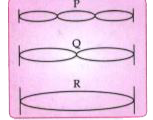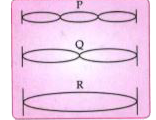Consider three P, Q, R, salts among them P and Q salts have different cations annd also have different coloured polyatomic anion due to charge transfer phenomenon while P and R salts have same cation but have different anions. Salts R decomposes into an acidic gas an a basic gas.
Q. Salt R can not be:
NH4NO3
(NH4)2CO3
(NH4)2S
NH4Cl
The correct Answer is:A
To solve the question regarding salt R, we need to analyze the information provided and the options given. The key points are:
1. Salt R decomposes into an acidic gas and a basic gas.
2. We are given four options to determine which one cannot be salt R.
Let's go through each option step by step:
Step 1: Analyze the options
Option 1: NH4NO3 (Ammonium Nitrate)
- Upon heating, NH4NO3 decomposes to produce nitrous oxide (N2O) and water (H2O).
- Both products (N2O and H2O) are neutral gases, meaning there is no acidic or basic gas produced.
- Therefore, NH4NO3 does not fit the criteria of decomposing into an acidic gas and a basic gas.
Conclusion for Option 1: This cannot be salt R.
Step 2: Check other options
Option 2: NH4CO3 (Ammonium Carbonate)
- Upon heating, NH4CO3 decomposes to produce ammonia (NH3) and carbon dioxide (CO2).
- NH3 is a basic gas, while CO2 can react with water to form carbonic acid (H2CO3), which is weakly acidic.
- Therefore, this option fits the criteria of producing an acidic and a basic gas.
Conclusion for Option 2: This can be salt R.
Option 3: NH4S (Ammonium Sulfide)
- Upon heating, NH4S decomposes to produce ammonia (NH3) and hydrogen sulfide (H2S).
- NH3 is basic and H2S is acidic.
- This option also fits the criteria.
Conclusion for Option 3: This can be salt R.
Option 4: NH4Cl (Ammonium Chloride)
- Upon heating, NH4Cl decomposes to produce ammonia (NH3) and hydrogen chloride (HCl).
- NH3 is basic and HCl is acidic.
- This option fits the criteria as well.
Conclusion for Option 4: This can be salt R.
Final Conclusion:
Based on the analysis, the only option that does not produce an acidic and a basic gas upon decomposition is Option 1: NH4NO3 (Ammonium Nitrate). Therefore, salt R cannot be NH4NO3.
2. We are given four options to determine which one cannot be salt R.
- Upon heating, NH4NO3 decomposes to produce nitrous oxide (N2O) and water (H2O).
- Both products (N2O and H2O) are neutral gases, meaning there is no acidic or basic gas produced.
- Therefore, NH4NO3 does not fit the criteria of decomposing into an acidic gas and a basic gas.
- Upon heating, NH4CO3 decomposes to produce ammonia (NH3) and carbon dioxide (CO2).
- NH3 is a basic gas, while CO2 can react with water to form carbonic acid (H2CO3), which is weakly acidic.
- Therefore, this option fits the criteria of producing an acidic and a basic gas.
- Upon heating, NH4S decomposes to produce ammonia (NH3) and hydrogen sulfide (H2S).
- NH3 is basic and H2S is acidic.
- This option also fits the criteria.
- Upon heating, NH4Cl decomposes to produce ammonia (NH3) and hydrogen chloride (HCl).
- NH3 is basic and HCl is acidic.
- This option fits the criteria as well.
Based on the analysis, the only option that does not produce an acidic and a basic gas upon decomposition is Option 1: NH4NO3 (Ammonium Nitrate). Therefore, salt R cannot be NH4NO3.
Topper's Solved these Questions
- TYPES OF REACTIONSBOOK - VK JAISWAL ENGLISHCHAPTER - TYPES OF REACTIONSEXERCISE - ONE OR MORE ANSWERS IS/ARE CORRECT
40 Videos
- TYPES OF REACTIONSBOOK - VK JAISWAL ENGLISHCHAPTER - TYPES OF REACTIONSEXERCISE - MATCH THE COLUMN
14 Videos
- TYPES OF REACTIONSBOOK - VK JAISWAL ENGLISHCHAPTER - TYPES OF REACTIONSEXERCISE - LEVEL 2
196 Videos
- s-BLOCK ELEMENTSBOOK - VK JAISWAL ENGLISHCHAPTER - s-BLOCK ELEMENTSEXERCISE - SUBJECTIVE PROBLEMS
2 Videos
Similar Questions
Consider three P, Q, R, salts among them P and Q salts have different cations annd also have different coloured polyatomic anion due to charge transfer phenomenon while P and R salts have same cation but have different anions. Salts R decomposes into an acidic gas an a basic gas.
Q. Salt P decomposes on heating into a coloured solid, neutral gas a neutral vapour, then which of the following can not be the product of salt P after decomposition?
View SolutionConsider three P, Q, R, salts among them P and Q salts have different cations annd also have different coloured polyatomic anion due to charge transfer phenomenon while P and R salts have same cation but have different anions. Salts R decomposes into an acidic gas an a basic gas.
Q. Salt P decomposes on heating into a coloured solid, neutral gas a neutral vapour, then which of the following can not be the product of salt P after decomposition?
View Solution
Knowledge Check
If P,Q,R are physical quantities, having different dimensions, which of the following combinations can never be a meaningful quantity?
A(P−Q)RBPQ−RCPQRD(PR−Q2)R
Consider three P, Q, R, salts among them P and Q salts have different cations annd also have different coloured polyatomic anion due to charge transfer phenomenon while P and R salts have same cation but have different anions. Salts R decomposes into an acidic gas an a basic gas.
Q. If salt Q underrgoes redox reaction with H2S in acidic medium then which of the following speies can not be possible product?
View SolutionConsider three P, Q, R, salts among them P and Q salts have different cations annd also have different coloured polyatomic anion due to charge transfer phenomenon while P and R salts have same cation but have different anions. Salts R decomposes into an acidic gas an a basic gas.
Q. If salt Q underrgoes redox reaction with H2S in acidic medium then which of the following speies can not be possible product?
View SolutionThe adjacent diagram shows three different modes of vibrations P, Q and R of the same string.

The sound of which string will have maximum shrillness?
View SolutionThe adjacent diagram shows three different modes of vibrations P, Q and R of the same string.

State the ratio of wavelengths of P and R.
View SolutionDraw a line and mark points , P,Q and R on it . Name this line in 6 different ways using the three points.
View SolutionIf P, Q, R are physical quantities, having different dimensions, which of the following combinations can never be a meaningful quantity ?
View SolutionConsider three charged bodies P,Q and R. If P and Q repel each other and P attracts R, what is the nature of force between Q and R ?
View Solution
